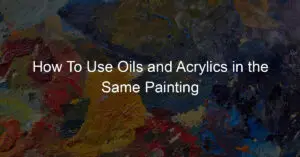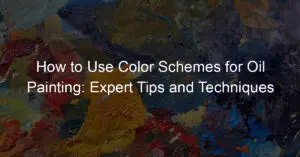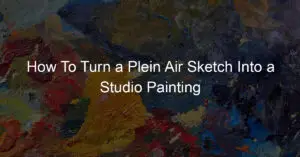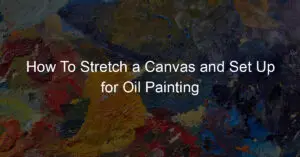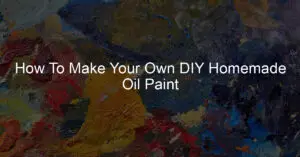Painting on a wet canvas can be a rewarding experience, as it allows you to create interesting effects with your oil paints.
To get the results you want, however, some important steps must be followed.
Begin by preparing the canvas and applying at least one coat of gesso or primer. This will ensure that the oil paint adheres properly to the canvas surface.
Once this step is complete, use a spray bottle filled with clean water to moisten the entire surface of the canvas. Make sure not to saturate it too much – just enough so that it appears slightly damp.
Next, mix your oils and mediums into different containers according to your desired color palette. If you are using oil paints in the sticks, you will need to grind them down into a paste before applying them.
Once the colors have been prepared, it is time to begin painting.
To achieve the best results when painting on a wet canvas, use softer strokes with your brush or palette knife and try not to saturate one area too heavily.
Keep varying your strokes for an interesting pattern and texture. You may also want to experiment with different techniques such as glazing, stumbling, and impasto for added effect.
As long as you don’t overwork the surface, you should find that the paint spreads easily across the moistened canvas.
Once you have completed painting, allow it to dry naturally or speed up the process with a hair dryer.
Once the painting has fully dried, you may want to apply another coat of gesso or varnish to protect your work.
Painting on a wet canvas can be an enjoyable and rewarding experience, especially if you take the necessary steps to ensure that you get great results.
With practice and trial and error, you will soon be creating beautiful works of art!
Can You Paint Wet-on-Wet With Oils?
Yes, you can paint wet-on-wet with oils. This technique is also known as “direct painting” or “Alla prima.”
The wet-on-wet process involves starting a painting on a wet canvas and then using liquid oil paints to lay down layers of vibrant colors that blend naturally.
As the layers dry, they form an image without visible brushstrokes or other muted effects typically caused by blending and manipulating the oils after application.
When working in the wet-on-wet style, it’s important to use thinner layers of paint as thicker applications may take too long to dry completely before continuing with additional layers.
Since drying time varies depending on the ingredients used and environmental conditions, it’s best to start with thinner layers and build up gradually.
Additionally, it’s essential to use a light touch when applying the brushstrokes to prevent the lower layers from lifting off.
Finally, wet-on-wet painting requires patience and trust in your artistic abilities.
It takes time for subsequent layers of paint to dry and blend evenly, so be sure to take breaks if you feel overwhelmed or stuck.
With practice, this unique style of oil painting can produce some amazing results!
Preparing a wet canvas for oil painting is not difficult and follows the same steps as preparing a dry one. The main difference is that you need to dampen the canvas with water before priming it.
Start by attaching your canvas to a flat, sturdy surface like a wooden board or frame. Then use clean water in a spray bottle to lightly moisten the canvas until it’s just damp – not saturated.
Allow the moisture to be absorbed into the fabric, then apply at least one coat of gesso or primer over the entire surface of the canvas.
Once this step is complete, your canvas should be ready for painting! Be sure to keep an eye on it while working and if necessary, reapply more water to the surface before adding additional layers of paint.
With proper preparation, your wet canvas should provide a good foundation for creating beautiful oil paintings!
How Do You Clean an Oil Painting on Canvas?
Cleaning an oil painting on canvas is essential to protecting and preserving your artwork for generations. A clean painting will also look much better than one that has accumulated dirt, dust, or grease over time.
To begin the cleaning process, lay down some newspapers or other protective material to cover your work area and prevent any accidents.
Then use a soft brush such as a makeup brush or artist’s paintbrush to gently remove any visible dust and debris from the canvas surface.
To remove more stubborn spots, use a mild detergent mixed with lukewarm water.
Dab the soapy solution onto the stains using a clean, soft cloth and carefully wipe away in a circular motion until the marks are gone.
Finally, rinse the painting off with clean water and allow it to dry completely before hanging it up.
Can You Paint Wet-on-Wet With Oils?
Yes, you can paint wet-on-wet with oils. This technique is also known as “direct painting” or “Alla prima.”
The wet-on-wet process involves starting a painting on a wet canvas and then using liquid oil paints to lay down layers of vibrant colors that blend naturally.
As the layers dry, they form an image without visible brushstrokes or other muted effects typically caused by blending and manipulating the oils after application.
When working in the wet-on-wet style, it’s important to use thinner layers of paint as thicker applications may take too long to dry completely before continuing with additional layers.
Since drying time varies depending on the ingredients used and environmental conditions, it’s best to start with thinner layers and build up gradually.
Additionally, it’s essential to use a light touch when applying the brushstrokes to prevent the lower layers from lifting off.
Finally, wet-on-wet painting requires patience and trust in your artistic abilities. It takes time for subsequent layers of paint to dry and blend evenly, so be sure to take your masterpiece.
Cleaning an oil painting on canvas is not difficult, but it’s important to use caution and patience when doing so to avoid damaging your work!
Conclusion
Painting on a wet canvas can be an enjoyable and rewarding experience if you follow these guidelines.
Whether you’re creating an all-prima piece or layering several coats of paint over time, make sure that you take into consideration the time required for drying and cleaning before starting your masterpiece.
With proper preparation and care, you can create beautiful oil paintings on either a dry or wet canvas that will last for generations!


